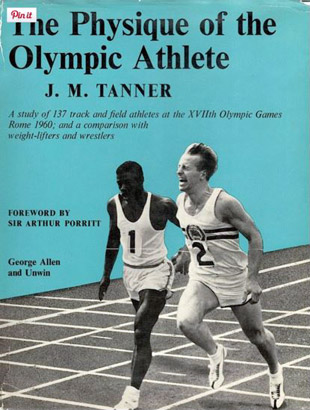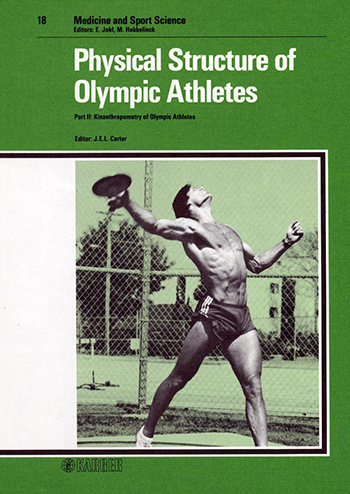The Olympic Games brings together the best athletes in the world in a wide range of sports. Over time it has provided a great opportunity to study the body size and composition of athletes from around the world and how that relates to performance.
Anthropometry of Olympic Athletes
We have collated data of the height, weight and body mass index (BMI) of the Olympic Games winners in a few events, and compared these over time. This gives a snapshot of how the body size and shape of elite athletes has evolved over the last 100 years.
- Olympic Track & Field anthropometric analysis of 100m Olympic champions and Olympic Marathon Winners
- Olympics anthropometric analysis of 100m swimming freestyle champions, and all-around gymnastics winners
- Anthropometry of Olympic Cross-Country Skiers
- Anthropometry of Olympic Football Players
- Anthropometry of Olympic Athletes in 2012, 2014 and 2016
- Height of Athletes at the Olympic Games - the tallest and shortest.
Published Studies of Olympic Athletes
Below are the details of some of the studies of the body size and shape of Olympic athletes, grouped by the Olympic Games they relate to.
1900: An anthropometric program was undertaken at the 1900 Olympic Games in Paris. Measurements were taken of height and weight, and of the different segments of the body, medical examinations, and also photographs were taken of various subjects in three aspects (front, back and side), and photographs of them performing their event. See details.
1928: A team lead by Professor Buytendijk set up a laboratory for testing athletes at the 1928 Olympic Games, collecting anthropometric, cardiovascular, x-ray and metabolic data. See details.
1928: Knoll, W., Ed., Die sportärztlichen Ergebnisse der II. Olympischen Winterspiele in St. Moritz 1928 (The sports medical results of II Olympic Winter Games in St. Moritz in 1928). Knoll was a pioneer in sports medicine, and professor at the University of Hamburg.
1932: Analysis of Olympic swimmers by Thomas K. Cureton. See details.
1948: results of Olympic Athletes published by T.K. Cureton, "Physical Fitness of Champion Athletes, University of Illinois Press, Urbana, 1951.
1952: Analysis by Ernst Jokl
1960 Rome Olympics: Cards to collect data were sent out to athletes before the games, however, there was a poor return rate. Instead, scientists set up a laboratory in Rome and were able to directly gather data from around 2000 athletes (see more details)
 cover of Physique of the Olympic Athlete by J.M. Tanner
cover of Physique of the Olympic Athlete by J.M. Tanner 1964: Olympic Medical Archives: Report, Tokyo 1964. Toshiro Azuma in collaboration with 5 co-workers edited a report with tabulated data based only on the files of the Olympic Medical Archives, including height, weight, somatotype ratings, and chest girth measurements. citation: Azuma T. (ed.) 1964, Olympic Medical Archives / Archives Medicaux des jeux olympiques, Tokyo: Japanese Olympic Medical Archives Committee.
1964:
- Hirata, Kin-Itsu. Physique and age of Tokyo Olympic champions. J Sports Med Phys Fitness. 1966 Dec;6(4):207–222
- Anon 1965a, 'Olympic Medical Archives Examination of British Olympic Team', Bulletin of the British Association of Sport and Medicine, 2: 25-32.
1968: Genetic and Anthropological Studies of Olympic Athletes. Edited by A. L. de Garay, Louis Levine and J. E. Lindsay Carter. Pp. 250. (Academic Press, New York, 1974). - used sum of three skinfold measures for body composition measurement of 1968 Olympic athletes.
- "The data which constitute the basis of this report were collected in connection with the XIX Olympic Games (1968) held in Mexico City. One thousand and sixty-five male and female athletes were studied, although all measurements were not taken on all athletes. Nevertheless, this comprises the largest collection of anthropological and genetic data on olympic athletes. A group of non-athlete Mexicans served as controls. The athletes represent 12 sports and 92 different countries. The data included; somatotyping; various anthopometric measure-ments; family participation in sports; birth order; taste threshold for phenylthiourea; blood groups, enzymes and proteins; finger and palm prints; and sex chromatin and more detailed chromosome analysis." from a review in Medicine & Science in Sports & Exercise, 7(2), vii, by Henry J. Montoye
1972: Sportwissenschaftliche Untersuchungen während der XX. Olympischen Spiele, München 1972 (Scientific tests during the XX Olympic Games Munich 1972), by H Jungmann Publisher: Gräfelfing: K. Demeter, 1976.
1972 Olympics:
- Novak LP, Woodward WA, Bestit C & Mellerowicz H (1977). Working capacity, body composition, and anthropometry of Olympic female athletes. J Sports Med 17: 275-283. - used skinfold measures and total body water for body composition measurement of athletes from the 1972 Olympics.
- Novak, L.P., Bestit, C., Mellerowicz, H., Woodward, W.A., Maximal oxygen consumption, body composition and anthropometry of selected Olympic male athletes, J Sports Med Phys Fitness,18 (2): 139-151, 1978.
- Novak, L.P. & Woodward, Wayne & Bestit, C & Mellerowicz, H. (1976). Working capacity (WC170), body composition, and anthropometry of Olympic female athletes. Sportwissenschaftliche Untersuchungen Während der XX. 69-78.
 cover of Physical Structure of Olympic Athletes
cover of Physical Structure of Olympic Athletes1976: There were many studies that came out of The Montreal Olympic Games Anthropological Project, including: Physical Structure of Olympic Athletes: Part I: The Montreal Olympic Games Anthropological Project., Part II: Kinanthropometry of Olympic Athletes. Edited by Lindsay Carter.
- Carter J. Somatotypes of olympic athletes from 1948 to 1976. En: Carter J editor. Physical structure of Olympic athletes. Basel: Karger; 1984. p. 80-119.
- Tanner J.M. 1976, '[Book Review] Genetic and Anthropological Studies of Olympic Athletes', American Journal of Physical Anthropology, 45: 125-6.
2012: In 2012 the IOC released a database containing data from most of the London Olympic Games participants, their height, weight, birth date, sport and country. See my summary and analysis of the data.
2016: In 2016 the IOC released a database containing physical data from most of the Rio Olympic Games participants, their height, weight, birth date, sport and country. See my summary and analysis of the data.
Unknown Olympic Year
- Bramwell C. and R. Ellis 1928, 'Clinical Observations on Olympic athletes', Arbeitsphysiologie, 1: 51-60.
- Best C.H. and Ruth C. Partridge 1929, 'Observations on Olympic Athletes', Proceedings of the Royal Society of London, Series B, 105: 323-32.
- Williams J.G.P. 1968, 'Olympic Medical Archives', British Journal of Sports Medicine, 3: 224
- Hirata, K., & Horvath, S. M. (1979). Selection of olympic champions. Santa Barbara, CA: Institute of Environmental Stress, Univ. of California. Book by Steven M. Horvath; Ed. Kin-Itsu Hirata?
Related Pages
- Olympic Track & Field anthropometric analysis of 100m Olympic champions and Olympic Marathon Winners
- Olympics anthropometric analysis of 100m swimming freestyle champions, and all-round gymnastics winners
- Anthropometry of Olympic Athletes in 2012, 2014 and 2016
- Anthropometry of Olympic Cross-Country Skiers
- Wimbledon Winners — there is a clear trend of the champion tennis players getting taller.
- Tour de France Winners — they are getting older and leaner
- NBA Players — how has the height and weight of NBA players changed over time?
- Football players at the FIFA World Cup — differences by position
- Athlete Body Size Changes Over Time
- Sport Specific Anthropometry
- Science and the Olympics
- Olympics Anthropology Days


 Current Events
Current Events